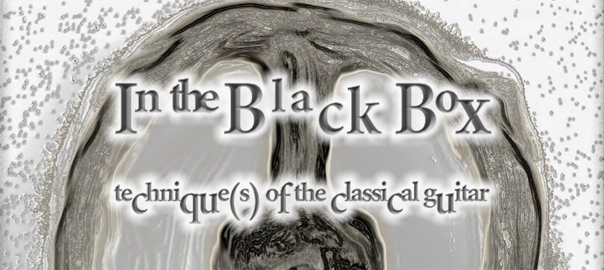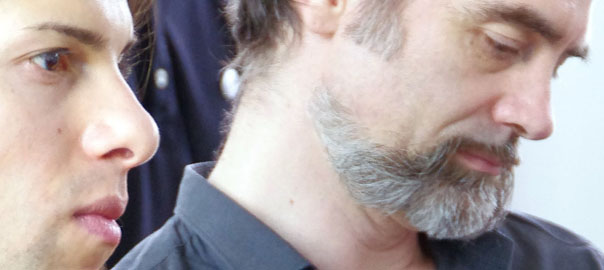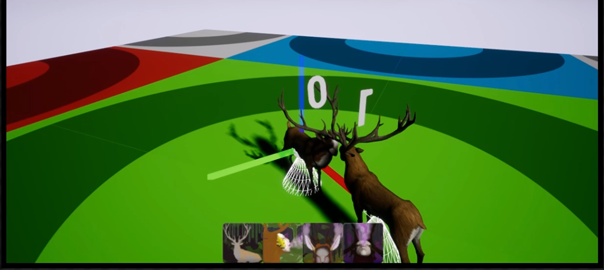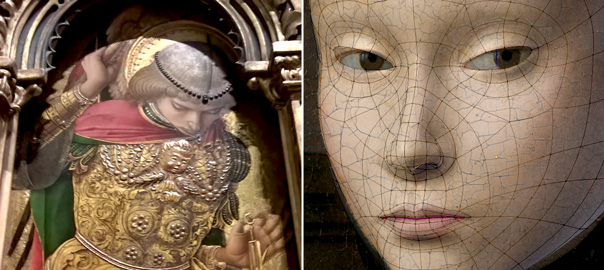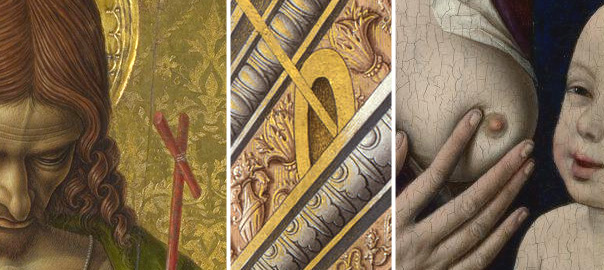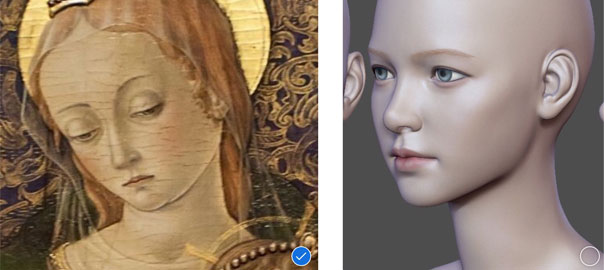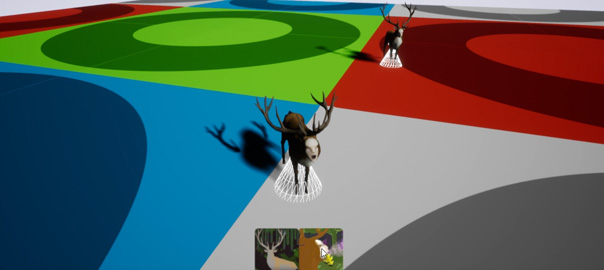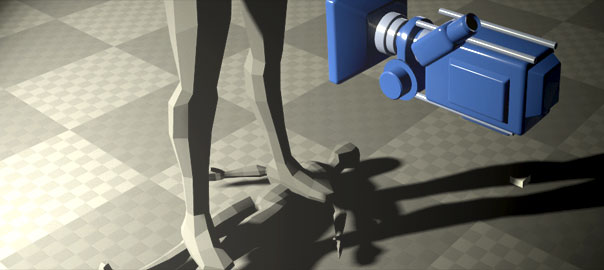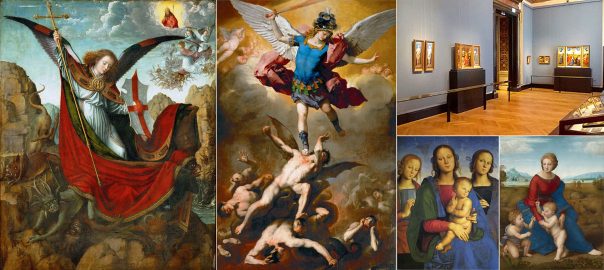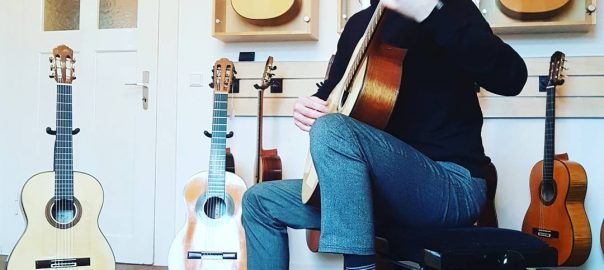From 29 May to 5 June 2017 I attended the Guitar Festival in Koblenz, Germany, a 4 hour train ride away from my home in Ghent, Belgium. I originally intended to simply sit in on masterclasses passively but the organizers assured me that the festival welcomes students of all levels. While I never felt unwelcome, as far as I have seen, I was the only student with such a low level. I have been studying the classical guitar for four years now, through weekly evening classes, but most -if not all but myself- festival attendees were young conservatory students who have been playing since early childhood. I asked one of them how long they had been playing guitar. “Twenty-one years,” they said. “How old are you?” “Twenty-five.”
The teacher in my first masterclass set me at ease by pointing out that I was an amateur, meaning a lover, of the classical guitar. True enough, I have no ambitions of becoming a professional musician. And most of these conservatory kids most definitely do. So any comparison is not even fair. “At least I’m not an adolescent boy,” I reassured myself.
Still, it was quite nerve-racking to participate in masterclasses with Hans-Werner Huppertz, Dale Kavanagh and Hubert Käppel. I seriously considered skipping the class each and every time. I already have considerable issues with performing in public. And I didn’t really see the point of confronting these master players with my amateurism at this stage. But in the end I thought of it almost as a joke, or a challenge or provocation for the maestros: let’s see what you can do with an amateur like this! In the end, though, each of the masterclasses turned out to be a very nice encounter and left me encouraged and inspired.
Next to actively participating in masterclasses I also sat in on classes with other students. That was almost as interesting, if not more. And most of what you will find below is based on these sessions. Next to the ones of the musicians mentioned above, I also sat in on masterclasses by Pavel Steidl and Marcin Dylla. And I saw some of the competition contestants perform and attended concerts by Marcin Dylla, Pavel Steidl, Pepe Romero, Scott Tennant, Manuel Barrueco and the Beijing Guitar Duo, and David Russell. Marcin Dylla made me cry. Lots.
What follows is a summary of the many things I have learned at the Koblenz Guitar Festival (and that will take me years to integrate in my practice), arranged according to subject and with the sources omitted to improve readability. Several master players addresssed related topics. So their words complement each other.
INTERPRETATION
The score.
The score used to be just a reminder of the music. It was not intended as a prescription.
Initially accept everything written by the composer, except if it is a misprint. And try to find out what happens when played exactly.
Figure out what the character of the music is. Is it sad? Brutal? Dignified? That is the primary question.
Not everything is written in the score. Especially dynamics can feel rather random. Feel free to change them according to your own feeling.
Opening.
The first chord decides how people will listen. The first chord draws people in. Play the first chord with gravity. Open your ears and draw people in from the first moment.
The first note of a piece should always be longer.
Phrasing.
Think of the dynamics in music as waves. A crescendo does not need to be linear. Chords succeed each other as waves of tension and release.
Forte does not mean simply playing loud. Let the volume grow. When building a long crescendo, start silently, go up and then take back a bit. A crescendo in steps feels lighter. Crescendo can mean playing piano for a long time and ending with a loud note. Sometimes the top of a phrase can be piano. Practically, on the guitar, a long note can never be pianissimo because it will not ring long enough.
Sometimes you can make a crescendo in warmth or beauty, rather than volume.
Combine crescendo with accelerando, decrescendo with ritenuto.
Play a wind instrument to learn about breathing between phrases.
Tempo.
Support tension with tempo changes. Rubato is okay in old music too.
If you repeat something more than three times you need to change the tempo to avoid monotony.
In romantic music, Dolce implies a change in tempo.
Activate rests by thinking “and”.
Think of the chord on the first beat of a bar as the result of the previous bar.
When Bach writes a bow, the last note is played short. In general, for Bach, short notes are better. But be careful not to make them sound funny or ironic.
The last note before a group of fast notes needs to be played faster.
Accents.
When there’s a surprising change in the music, show the note. Dissonances should ring a little longer. Pronounce the most tense chord more, through arpeggio. But don’t exaggerate broken chords. Avoid the kitschy harp effect.
On a rhythmical accent, pronounce the note longer. Rubato can be used to create accents.
You don’t always need to bring out the melody. Sometime that sounds too heavy.
Shape the bass note, don’t let it ring as part of the harmony in polyphonic music.
TECHNIQUE
Simplify.
Fingering doesn’t matter if you have a musical idea. Just choose the easiest. Make the left hand fingering easy and compensate for musicality in right hand intonation. Simplify unimportant bass chords and bring out the melody. If you have too much trouble with the fingering, remove one note from the chord.
Sometimes you can simulate legato by letting overtones ring. This is often easier, more relaxed and more musical.
The melody may be played on multiple strings.
Use slurs as a technical solution for fingering. Triplets are more exciting and clear with slurs from the first to the second note.
Energy.
Play efficiently. Use the right amount of energy. When you lift a finger move it to the place you’ll need it next.
Relax the hand immediately after arpeggio.
Volume.
To play Forte push the string deeper. Stress the string first, release in the highest tension. Pretend you’re playing apuyando when playing tirando.
Don’t try to get from the guitar what’s not there. Be careful to not exceed the instrument’s capacity when playing Forte.
On the guitar, playing too loud is a bigger problem than too silent. Loud guitar playing can sound dirty (which is fine in Flamenco but not in classical music).
Right hand technique.
Have the resting thumb follow the playing fingers so they always attack with the same angle. If thumb stays on E, for example, different strings will sound differently because of the different angle.
The three fingers produce different sounds. We need to figure out how to make them sound similar to each other. Different fingers may need different nail shapes. But also different angles. Get to know your hand, and the differences between your fingers.
Tremolo is just an arpeggio with a balanced sound.
Always have your right hand fingers come out immediately after playing. Don’t keep the fist closed. The finger joints have to behave like mechanical springs.
To play chords on the treble strings, hold the fingers close together. To make one string louder, slightly extend the corresponding finger.
Left hand technique.
The left hand is important because it’s controlled by the right hand side of the brain, the creative side. The right hand is controlled by the mathematical part of the brain. We can think of the left hand as the hand of the piano player, the artistic element, and of the right hand as the piano hammer, the mechanical element.
To get the right tension in the left hand, pretend you’re holding an orange or an egg that you can’t break.
You can move to the comfortable position gradually, by finger walking, rather than shifting quickly. Compensate for color differences between positions.
Shifting & glissando.
A position shift creates an accent, so avoid shifting when an accent is undesirable.
When shifting, lift fingers on bass strings, to avoid scratch sounds. But keep the fingers on the treble strings for stability and legato. Slide with more flesh and push harder to avoid scratches. You can cheat on a shift by making legato on only one note.
A glissando does not need to be linear: speed up at the end and add pressure. No need to hit every fret.
POSTURE
Don’t hold the guitar too high because a high hand requires more energy.
To find the right position, open your arms and close them so you hold the guitar like baby in your arms.
Move the whole body forward when playing vibrato.
Change body positions throughout the piece. Act out different roles to embody the emotions. Assume irregular poses where they fit the expression.
Look up when you go to the first beat, like coming up from under the water.
You need to feel the vibration of the guitar in your body. Hear the resonance.
NAILS
A nail shape that follows the round shape of the fingertip allows for attacking the string from all sides of the fingertip.
Try to play apuyando with same hand position as tirando. This doesn’t work when nails are too long.
You create lower overtones with the flesh of the fingers.
TONE
Imagination.
When you play only think about the sound, not the fingers. Our imagination makes the sound. More than your nails and such. Your sound will never be more beautiful than you can imagine. To change the sound, change the imagination.
Do a sound search until you find the feeling.
Pretend you’re a cellist. Especially with melody in the bass. This helps legato flow more.
Think of how wonderful the guitar can sound.
You have to force your imagination to a higher level.
Right Hand.
Modern guitarists rarely play apuyando these days. Most sounds can be achieved through tirando.
Different attacks correspond to sounds the voice makes: staccato tirando produces the sound i (ee), staccato tenuto sounds like a (ah) and staccato apuyando is o (ow).
Use your entire arm to attack the string. As an experiment, try to make the sound starting with the right arm stretched out sideways behind your body, circle up towards the string and attack. Then make smaller circles with the arm. Like moving through water. Then, with the same feeling, play with the arm resting on the guitar, Then only from the shoulder. Then only from elbow. Then just from the wrist.
You need to feel the tension of the string before the sound. A guitar is like bow, You need energy to shoot.
Left Hand.
We can also help articulate the sound with the left hand. While pressing the string, put pressure on the fretboard after playing a note, with the weight of your arm. The weight of the arm can produce much more beautiful sound than energy can. Make circles with the elbow and hear how the sound changes. This helps the guitar sing. You can move your torso forward when you do this. Without actually changing the pitch! It’s not vibrato. You can make the sound swell by adding pressure. And on the highest pressure, you can add vibrato.
Always use vibrato, always make the guitar sing, if only for projection. But only start the vibrato when the sounds stops growing. Then the vibrato reanimates the sound somewhat, extending the note.
A secure left hand improves the sound.
Move the guitar after plucking to manipulate the sound.
PRACTICE
Fast passages.
In general, practicing slowly is good. But if the music ultimately needs to be played fast, like tremolo for instance, it’s a bad idea. You make different motions when you practice slowly. You study walking, not running. But if the passage needs to run, you need to study running motions. When you play slowly you can make motions that are not possible when playing fast. When playing fast your motions become more relaxed because they are smaller.
To practice fast arpeggios, divide the passage in small parts and start playing them as unarpeggiated chords with long pauses in between. Start with only the right hand on open strings. It takes longer to learn both simultaneously. Then slow down the arpeggios and decrease the length of pauses. Then you make the correct movement, without excess.
Always try to put as many fingers as possible on the strings beforehand. That makes the motion smaller.
Play with the right hand only until it feels easy. Then, practice slowly to coordinate with the left hand. Since you’ve practiced with the right hand correctly, it will do the right motions, even when playing slowly.
Practice this on piano level. Dynamics are extra work. You only need to learn the motions at first.
Research.
Just repeating something is a waste of time. Experiment with different fingerings until you find the easiest. You can always change fingerings later. The brain can learn this easily when you’re familiar with the piece.
Change approach during practice. Don’t just repeat. When you played a phrase well figure out how to you did it instead of repeating over and over. By listening to your own experimentation you enter the zone: open your ears to hear the connection.
Find phrases that create tension by exaggerating slowly.
Play the first chord in five different ways to find the one you like. Just play the first two chords. That’s your whole world.
Try to sing the overtones. Breathe abdominal. Sing along with the string, modulate your voice to find the overtones. Put energy in the note.
Memorization.
Memorization includes phrasing.
Speak along with the melody -by saying the note names for instance- to help concentrate on the music when playing for others.
You should figure out the right hand fingering beforehand, including which string the thumb will rest on.
The fingers will do what you want but they need to know what you want.
Observe yourself.
Recording yourself is your best teacher.
Play around with left hand motions in a mirror.
Organization.
Practice each part until it becomes easy. Set goals for a few bars at a time. But also play the piece fully every day to retain an overview. Make sure to end every practice session with satisfaction.
Practice from the end to the beginning. So later when playing the whole piece you find security.
If you practice more than 3 hours per day, you’re doing something wrong. Be concentrated.
And also study and think without the guitar. With score and guitar. With score without guitar. Without score with guitar. Without guitar without score.
Do the hard part 20 times every day for a couple of months.
Take your time in details. Don’t go too fast. Sometimes it’s better to practice a few passages instead of the whole page.
Play the melody separately to shape the phrase. And then try to keep the phrasing when the rest is added.
Don’t hurry towards difficult pieces. Playing a piece of level 3 on level 10 is better than playing a piece of level 10 on level 3.
Rhythm.
Practice the chords first without arpeggios because they affect the rhythm. First make sure you play in time.
Body movement is better than a metronome. Sing or speak the rhythm as you play.
Exercise to avoid squeaks.
Walk on 4th or 5th string while skipping a fret with thumb and index finger, and prepare to mute. Move the elbow when changing positions, while the finger is relaxed.
Technique.
To play guitar you need arpeggios, scales and slurs, in that order. Practice them for hours.
Arpeggio practice is relaxing for the right hand. It takes no effort.
PERFORMANCE
Personal observations.
It’s not attractive when it the player seems to be having difficulty. Apparent ease is more important than playing correctly.
Passion is attractive. Some musicians seem to be able to convert their nervousness into energy, or even aggression if it is appropriate for the piece or a passage.
Playing silently on stage is an act of courage. When done well, the audience will become very quiet in order to hear.
Some players have a little routine before they start playing, to help concentration. Others prepare very little. Maybe they become concentrated while tuning between pieces. Or they find their concentration in the first notes. They find peace in the music, they settle any nerves in the sound.
Ending a piece with a bang provokes applause.
Maestros make music feel important. Students are just going through the motions.
EPILOGUE
I have learned a lot about playing the classical guitar during one intense week. This will keep me going for several months, if not years. But I have also seen a darker side of the classical guitar world.
Many students, and even some masters, seem to approach learning to play as a kind of sport. They want to achieve. Things are categorized in levels, as in a game. They treat scores like puzzles to solve. A lot of the work they do seems to involve mindless practice.
Perhaps this correlates with the bad visual aesthetic taste I have observed in many musicians. Their music isn’t born from an artistic sensibility. (How could it? They are too young, they start too early, like sports people.) There’s a certain rather well defined way the guitar is supposed to be played and they learn it. This includes rules about interpretation as well as technique. Maybe working like this is required to reach the high level of the superstars. But many seem to get stuck in this competitive mindset and never actually become artists.
The few that do, however, the few that manage to create art on the instrument, sounds that move the heart, are immensely inspiring. They make music feel exciting. Their enthusiasm is infectious. It’s hard to believe that their attitude grew out of the rather sports-like training that seems to be the norm.
The master players do insist time and again that it’s about music, it’s about art, it’s about emotions. But they don’t seem to have a method to transfer this concept to the students. Classical guitar technique is so difficult that students are almost forced to ignore the artistic aspects in favor of continuously improving their technical skills, playing by the rules.
This makes me happy that I’m just an amateur. I can take my time to explore the sound that the instrument makes. Of course I want to play Asturias or Recuerdos or Chaconne one day. But not at the expense of creating beauty. And there’s a lot of beauty in much simpler music.
Rant against the popularity of double top guitars.
―Michaël Samyn.
